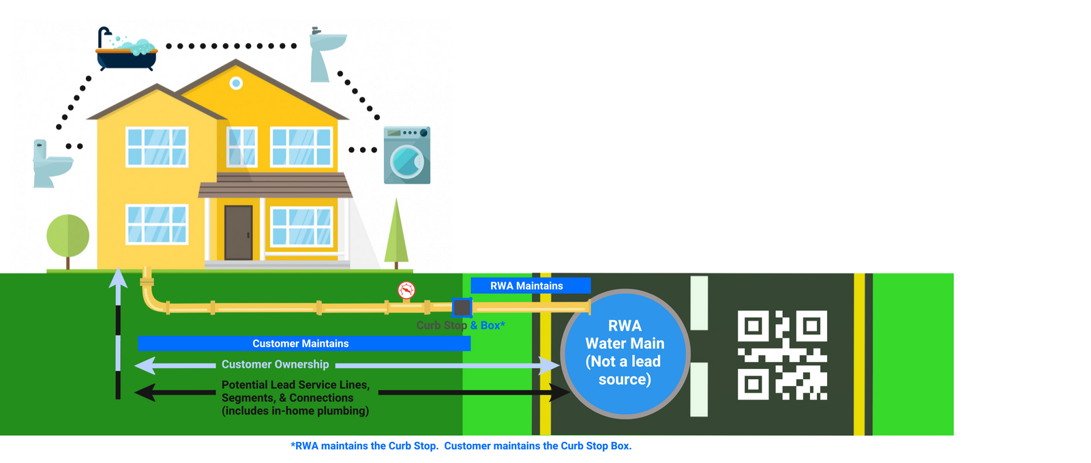What is the EPA’s New Lead and Copper Rule for Drinking Water?
In 2021, the U.S. Environmental Protection Agency (EPA) revised the Lead & Copper Rule (LCR), a series of regulations aimed at protecting public health by reducing the potential for exposure to lead through drinking water. The revisions added new protective measures specifically focused on mitigating exposure to lead from the nation’s public water systems and plumbing in private homes and businesses.
While the revised LCR reporting will not take full effect until October 2024, our work to comply with the revised Rule is already taking shape. Steps to meet the new regulations began in earnest over the past year and will continue over the next 18 months. This will include a respectful ask for our customer’s help us identify lead pipes on private property.
RWA’s Commitment to Lead-Free Water
For more than 170 years, we consistently met all the evolving regulatory standards on water quality and provided you with high-quality water and services.
It is important to note the water that leaves the RWA’s water treatment plants and travels through water mains to homes or businesses has no lead in it. However, as water sits in any lead service lines and some home plumbing systems, small amounts of lead from pipes or solder may dissolve into the water. To protect you from this kind of lead exposure, we add a corrosion inhibitor to our water that creates a protective coating on our pipes and homeowner’s plumbing. This coating helps prevent lead from potentially leaching into the drinking water. It is proven to be safe and effective, and is approved by the US Environmental Protection Agency and the Food and Drug Administration.
Because of our long-term commitment to removing utility-owned lead lines, our treatment process, and our corrosion control practices, we have easily met the EPA’s lead regulatory standards since lead testing began in 1992. Our more recent success in protecting our customers from lead can be found on the Lead Testing Data page of our website.
What is RWA doing to continue protecting our customers under the Lead and Copper Rule?
Initial Lead Service Line Inventory Work
To find lead wherever it may be in every water system in the country, the EPA’s revised LCR contains a new requirement that all public water systems nationwide develop an “initial inventory” of all their water service lines and connections, including – for the first time ever – all the water lines and connections on private properties.
A “service line” is the underground pipe carrying water from our main to a home or business. Each service line requires connections to the water main, the customer’s properties, and interior plumbing. Each service line and connection may consist of multiple plumbing material types, including lead, copper, iron, brass, and plastic.
We are responsible for the water line and connections between our water main in the street and the “curb stop,” our connection on the water line where the water can be turned on and off.

While we removed all known lead service lines from our side of the system for the safety of our customers in the 1970’s and early 1980’s, there remains a possibility that lead service lines and connections could exist in some portions of our more than 1,700-mile system of water pipes. There is also the possibility that service lines, connections, and fixtures on private properties or within homes or businesses could contain lead.
We will continue our proactive approach that has long protected you from lead exposure. We have already started our inventory work by reviewing our records. In the coming months, we will conduct water testing, use predictive modeling, and, in some cases, dig down to physically investigate water lines, all to find any lead infrastructure within the system we maintain.
Because we serve 15 South Central Connecticut municipalities, this process will take time to conduct and complete. In addition to our ongoing efforts, we will also partner with our regulators, health departments throughout our service area, local elected officials, and community leaders to make sure everyone is fully informed about our progress, especially when it may directly impact homes or businesses.
What can you do to help?
The revised LCR requires us to investigate whether water service lines or connections on or within private customer properties contain lead. Because this work must take place on private property, we cannot access it without your permission. We will partner with you to access your property with minimal inconvenience.
Private water service lines and connections are the customer's responsibility. We understand that some customers may wish to avoid looking for lead on or within their properties. We will use a process that respects your privacy, but the new regulation requires water purveyors to include our findings on a publicly available map on our website beginning in October 2024.
We respectfully ask you for your assistance in several ways, including allowing us to access your property and/or for your participation in a water service line self-identification survey.
You will also have the option of inviting us into your home or businesses to check your lines and connections for lead.
Public Information
In addition to actively updating this webpage, RWA will use customer letters, postcards, door hangers, bill messages, and other communications tools to reach out to you as we start collecting data. We will provide information through the news media and social media, and work with local officials and community leaders to ensure you can find the latest details about our efforts.
More Information
For more information on lead in drinking water, please visit the EPA's website.
You may also call us at 833-RWA-LEAD (833-792-5323)


